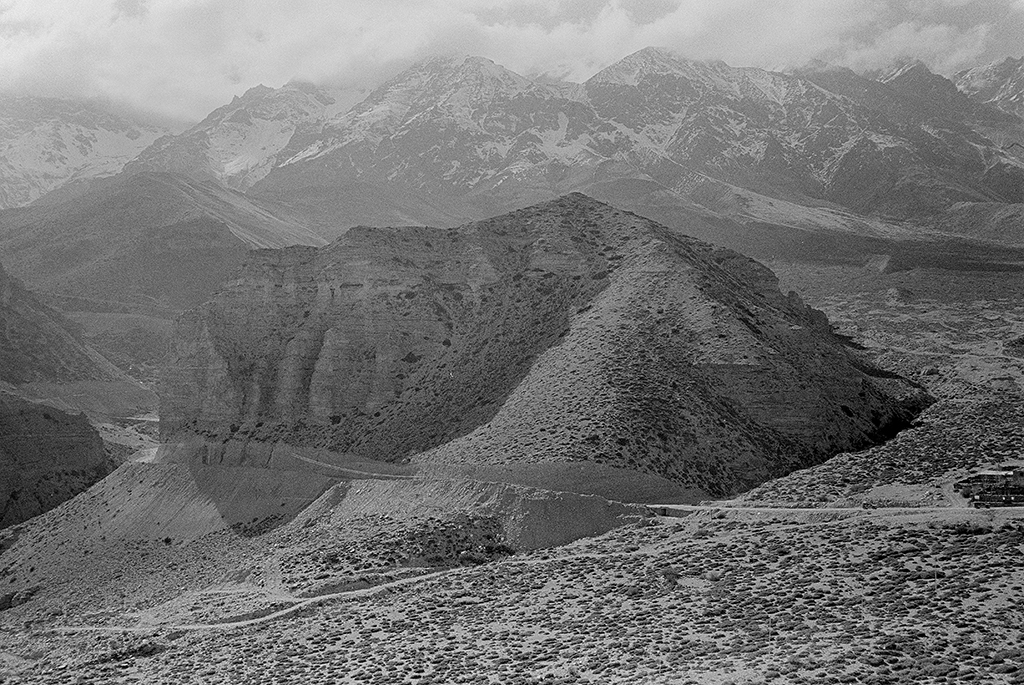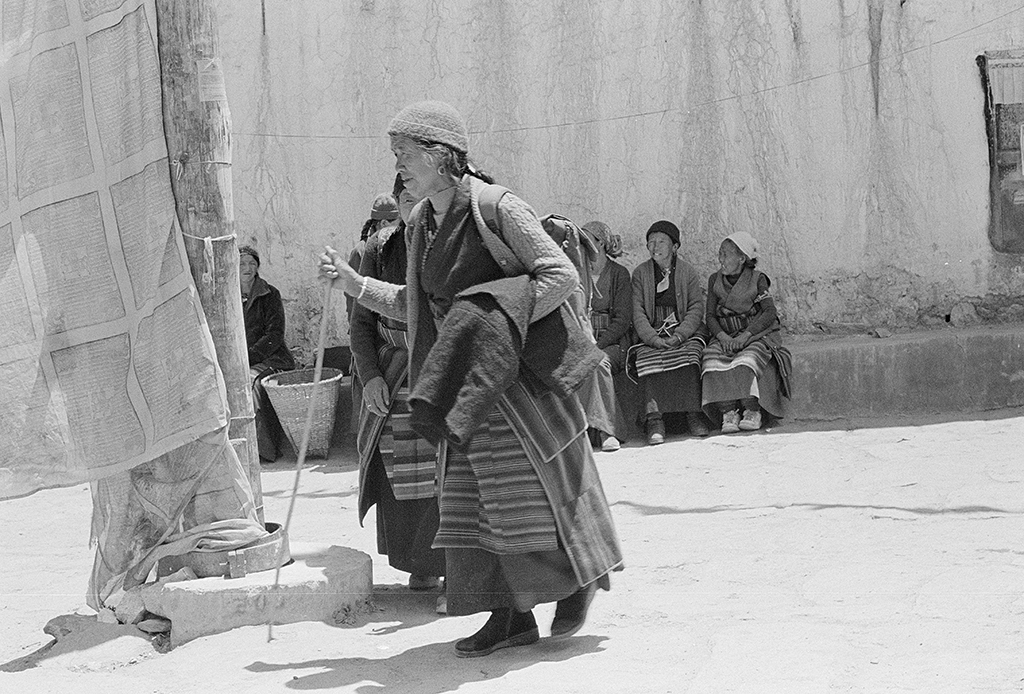
Spectacular, vast, awe-inspiring, mind-boggling, none of these adjectives comes close to describing the landscape of Upper Mustang in Nepal. That’s why I’m a photographer rather than a writer. The scale of these mountains is vast. If our 4WD Jeep were in the scene, it would be just a tiny speck on the road. The subtle play of light and shadow makes the image more dramatic.
The setting for this episode is the Mustang region of Nepal. The landscape of Mustang was the most striking feature. And what landscapes. Especially Upper Mustang which is high desert with mountains of solid rock and compacted sand, devoid of vegetation except for small scrub bushes, is an otherworldly place. It left me with two impressions. The first was the feeling of how small I was compared to the vastness of the mountains. The second, and stronger, impression was the scope of geological time compared to the existence of Homo sapiens as a species. Both of these impressions left me feeling that we humans are rather insignificant in the wider universe.
Such conditions forced me to challenge some of my perceptions about photography. Generally I focus on people and their cultures as subjects for my photography. Landscapes are just part of the background. The overpowering landscapes of Mustang forced me to re-think my outlook.
Fortunately I was able to capture a few, very few, suitable photographs. Clearly landscapes play a more prominent role in this episode of The Monochrome Chronicles than in other episodes. This is inherent in the theme “Mustang.”


The perspective of distance, or maybe the misperception of distance, enlivens this image. The mountain in the center seems to rise out of the flat plateau. Behind it – far, far away – stands another mountain range in the background. And, just peaking above the horizon hovers the snowcapped Himalayas. Our highway and a local trail appear to be miniscule white stripes near the bottom of the scene.
A reminder of the changing seasons, this is the River Kali during the dry season when the river dwindles to a few meandering streams in the river bed. The monsoon season will swell the waters so that the river spans the entire width of the sandy river bed. This image appears to portray a river of sand.


Here Hindu people were conducting a Shiradda ritual for the dead. They strip down and wrap themselves with a long white cloth, then wade into the river to pray for their ancestors to give them a safe passage to the next world. Though the April weather was cool, steam was arising from the river in the background.
Often I claim that for expressive photography I must follow my camera and listen to my little inner voice. At times a third force intervenes – serendipiity. Then images such as this emerge, bordering on abstract expressionism. I’ll resist the temptation to explain or interpret. Let me just say that sometimes sunlight plays tricks with the landscape.


Echoes of Tibet. This woman from the village of Ghami was wearing traditional Tibetan clothing, as do most of the older women in her village. Historically, Mustang was part of Tibet but was surrendered to Nepal after a border war between the two countries. Some Tibetans remained in Mustang afterward. Their descendants hew to traditional Tibetan customs.
The impenetrable cast on this woman’s face is magnified by her surroundings. The weathered wood in the column behind her, the adobe bricks eroded by time, even the shadows in the background, reflect her stoic countenance. Her clothing, traditional Tibetan style except for the down coat, likewise seems to add another layer of impenetrability.


Street photography in Mustang. Or maybe not. Two elements fight for dominance in this image. First, of course, and the main focus, are the two women waking along the cobbled street, maybe engaged in their everyday morning chores. Everyday maybe but the early morning light embraced one of the women, drawing attention to her as the main subject in the image. The second element, relegated to the background but still essential, is the architecture of this village. Here and in other isolated villages in Mustang many aspects of the architecture reminded me of scenes from the Middle East or from Arab countries. Maybe that is not so surprising, since Tibet once was on the Silk Road. In this instance the main subjects and the background meld into a unified composition – just a usual morning in Ghami village.
Sidelighting from the morning sun streaming through a bank of windows created suitable conditions for this photograph of a cook at the guesthouse. Coincidentally, the lighting, as well as the post in the center, differentiates the kitchen in the background from the dining area in the foreground. Though the exterior of the guesthouse was monochrome adobe and stone, the interior boasted bright colors – predominantly pumpkin orange with accents of emerald green and royal blue. Though she feigned reluctance the woman sat patiently for my camera. In all, a complex composition that reflects the ambience of a guesthouse in Mustang.


Snowcapped Himalayas played cat-and-mouse with my camera. At times they seemed to disappear behind the mountains of Mustang, only to reappear around another bend in the road. The perception of distance was deceptive, making the Himalayan peaks seem nearby when actually they were far distant.
The scope of the vista defines the point of view in this image. A huge treeless sandhill dominates the foreground. A hard-rock mountain, with a road snaking along near the bottom, dominates the midground. The road seems to point to another mountain range, this one showing a more characteristic corrugated appearance from the erosion of sand away from the hard rock substructure. A microscopic glimpse of snow-capped mountains, Himalayas of course, peeks over the horizon in the far distance. Scenes like this were what impressed me with how small we humans really are in comparison.


Two women in traditional Tibetan clothing were sitting in the late afternoon sun in the courtyard outside the King’s palace in Lo Manthang. The years of living under the harsh Mustang sun are visible on their faces.
The traditional Tibetan costumes of women in Lo Manthang. The streets were largely vacant, a reflection of the dwindling population of this settlement, which used to be the capital of the kingdom of Upper Mustang.


A community ritual at the monastery in Lo Manthang. At one end of the long narrow room a monk intoned chants. The worshipers, mostly women, sat cross-legged on the floor by the long wall, some spinning prayer wheels and others sitting quietly.
The harsh Mustang sun predominates in this image but also emphasizes the shadows in the background. The composition incorporates both the human element and the architecture. It conveys the impression of an ordinary afternoon in a village in Upper Mustang.

The monastery in Lo Manthang is home to hundreds of young monks. Despite living with so many boys near his own age, this guy reflects the loneliness of having been separated from his family only a few months before. Presumably his loneliness would pass with time.

Again with a nod to serendipity. My camera has transformed the rugged terrain into a smooth dream-like otherworldly vista. The image projects a painterly aura, a portrait of a place that exists only in the imagination.

Late in the afternoon as the sun approached the horizon, shadows prevailed in the landscape, creating a softer palette for photography. The lack of detail contributes to the strength of this tranquil image.
This episode of The Monochrome Chronicles is a review of my photographs from the Mustang region of Nepal. I recognize now that I had few expectations before the trip – which is essential for my approach to photography – and more importantly, nothing could have prepared me for the experience. Clearly the extraordinary landscape of Mustang dominates the photographs in this episode. Ironically, as soon as I returned to Bhaktapur from Mustang my experiences there already seemed like a dream. I suspect that Mustang had cast some sort of mystical spell on me, hypnotizing me. The immense scope of the landscape and the feeling of timelessness held me spellbound. Now, from the perspective of Tokyo, the negatives and images speak to me from an uncommon point of view. This is difficult to explain. Perhaps I yielded so much to my camera and my little inner voice while I was in Mustang, and therein lies the spirit of these photographs.